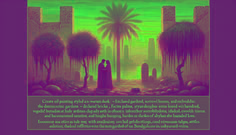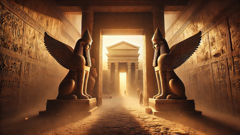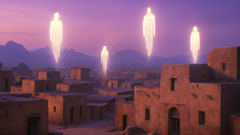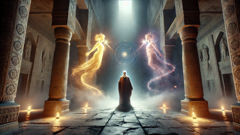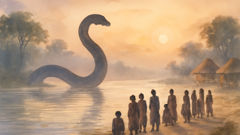Introduction
Along the slow, meandering arteries of the Euphrates and Tigris, where reeds quiver and the mud-brick cities rise like islands of prayer, voices once told a tale that stitched the sky to the earth. In the hush that follows the cry of cranes and the hush of oars against the riverbank, the story of Enlil and Ninlil begins with a look—brief, electric, impossible to unsee. Enlil, lord of the wind and the high heavens, moved with the gravity of storm and throne; Ninlil, daughter of the river and of soft speech, bore a gravity of her own, tied to the earth’s cool edges and the hush of temple courtyards. They met at the water where garments brushed reeds and sunlight fractured into scales on the current. What follows in clay tablets and whispered praises is not merely a chronicle of gods and genealogies: it is an ancient meditation on desire and law, on the mortal ripple of a transgression and the long arc that bends toward justice and reconciliation. In places like Nippur, where temples stack the sky in graduated steps and priests chart the heavens for the sake of human fate, the myth became a lesson as well as a lament. It explains how the moon was born into the company of gods, how silence became exile, and how the smallest human impulses can move the cosmos. The story that we now retell unfurls as a river itself—traced by reed, sky, and footfall—and invites listeners to feel the salt of reckoning, the warmth of longing, and the pale comfort of lunar light that would come to govern months, tides, and the rhythm of offerings.
Courtship at the River: Desire, Deed, and the First Child
In the earliest hour when the city-mounds still held their breath and the dust had not yet risen, Enlil descended from his high hall to walk the river. He came as the wind comes—without announcement, felt more than seen—bringing with him the scent of juniper, thunder, and dry cedar. The city of Nippur, closest to the great temple of Ekur, kept its rituals by the measurement of his moods; priests made their offerings with an eye to the direction of his breath. Ninlil, daughter of the waters and known for a voice as soft as reed-thrum, frequented the riverbank in the morning, washing linens and offering bread to the current. She moved in a world of small, certain labors: loaves to be smoothed, hair to be braided, and the hush of prayer to be layered into the cracks of everyday things. When Enlil saw her, the sky seemed to lean. That first look is told in fragments across the tablets—a tilt of head, a quickened breath, a glance that carries the weight of the firmament. What the scribes preserved was less an account of consent than a chronicle of consequence: Enlil addressed Ninlil, and in the ancient telling, what began as speech became an act whose propriety would later be judged by councils of gods.

They met beneath a willow’s tremor, where the current spilled into a shallow pool rimming with green. Enlil, unbounded by the same laws that enclosed mortal men, moved with the authority of a god who believed his will could fold reality. Ninlil, wise yet young in the ways of the divine, listened and answered, and the meeting that should have been a private exchange was transformed by the urgency in Enlil’s manner. In some versions the encounter is tender; in others it is transgressive—an imposition that will later be held up as reason for punishment. The ambiguity holds a lesson that Sumerian priests kept close: even gods act within a web of consequences, and the texture of desire can be both creative and destructive. From that episode a child was conceived—Nanna, who would become the luminous eye in the night. Nanna's coming altered the very light by which humans marked time. Where months were once measured by season and sowing, they became measured by the moon’s countenance, the gentle bloom and wane that would govern planting, fasting, and the cadence of temple offerings.
Word of the encounter that birthed Nanna did not remain at the water's edge. In the halls of the gods, where council and decree are made by breath and by the naming of wrongs, Enlil's deed was weighed. The celestial assembly valued order above the caprice of a single god, and Enlil, despite his station, was called to account. The punishment pronounced by the divine court was exile—a ripping away from his favored place among the high airs and a descent into the world below. The decree did not simply banish him; it set a drama in motion, a pilgrimage that would drag the consequences of desire through the underworld's threshold and force the gods to confront kinship, shame, and the necessity of atonement. That exile, and the subsequent births and episodes it provoked, would etch the myth into the calendar and the temple, teaching mortals how the celestial order could soften toward reunion and how the moon—Nanna—emerged as both child and witness to the law of the gods.
Exile, the Underworld, and the Moon's Luminous Birth
Exile in Sumerian imagination was not a simple relocation; it was a stripping away of favor, name, and the sanctity that attends the gods' accustomed places. When Enlil was cast out from his throne-like parapet, the descent meant more than punishment: it was an unraveling of the usual order, a test of kinship and of cosmic consequence. Ninlil, whose life had been braided with the rhythms of water and prayer, found herself thrust into an uneasy sequence of choices. To be the mother of the moon placed her at the heart of an unusual dilemma—did she follow a god into disgrace, or did she preserve the rhythms of the earth and the sanctity of the temple? Myth insists that she followed—partly from love, partly from an obligation to the child she bore, partly because the story of gods and humans is often braided with acts that defy tidy moral categories.
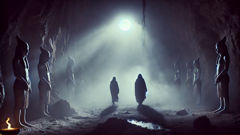
The underworld in Sumerian thought was a place of dust and dim light, ruled by deities who measured out fate with patient cruelty. Enlil's travel into that realm was not a single step but a sequence of machinations, disguised approaches, and tests of identity. Each time he assumed a new guise, he did so to be near Ninlil, to persuade her to join him, and each time the pattern of concealment and discovery informs the myth's taut nerve: identity can be worn like garments, and speech can be both armor and undoing. The gods of the underworld—irrigators of the dead and conservators of names—watched as Enlil, who had been lord of winds, negotiated with fate in a place where breath is thin and the air tastes of ash. It is here that the myth multiplies its children: in the darkness, where names are whispered and given form, Enlil and Ninlil conceive further gods—figures who will account for the evenings, the places of shadow, and the rites that bind the living to those who have passed. The births in the underworld, paradoxically, expand the cosmos: from descent comes multiplication; from loss comes new authority.
Among those born in shadow was Nanna, the moon whose pallid face would come to govern months and mark the rhythm of temple feasts and agricultural cycles. Where the sun orders the day, Nanna orders the longer pulse of life—the waxing and waning that mothers watch for in the field and priests watch for in the hall. His birth is narrated not as a single bright appearance but as a slow acclimation, a waxing presence that fixed itself in the sky and in the calendar. People learned to address the moon as kin, to set tables under its phases, to carve stories into clay that reminded them of its origin. In the mythic aftermath, reconciliation takes shape: Enlil is not eternally cast out. The gods, constrained by the same pragmatic logic that governs human courts, negotiate a return, a partial restoration of place and name. Yet the cost and the memory of exile remain. The tale becomes a charter: it explains why certain rites are done at the moon's first sight, why priests chant particular laments before offering bread, and why the moon itself is alternately benevolent and a keeper of secrets. By making the moon both child and mediator, the story gives a divine answer to the irregularities of human life—their failures, their reconciliations, and the uncanny way that even transgression can yield something luminous and necessary.
Conclusion
The tale of Enlil and Ninlil endures not only because it tells of gods who love and err, but because it encodes a human way of understanding how order emerges from passion and how consequence shapes community rituals. In the clay tablets and temple hymns of ancient Sumer, the myth became both a family portrait of the divine and a manual for practice: it justified festivals that followed the moon’s cycle, shaped laws about transgression and restoration, and taught leaders that even power demands accountability. Nanna’s pale face rose from a private encounter and a punitive descent into a fixture that regulated planting, marriage, and mourning. In the reedbeds and on the ziggurat terraces, offerings were made to a god who was also a child conceived amid complicated loyalties. For modern readers, the story remains a reminder of how cultures lean on narrative to order the world: how myth can sanctify the rhythms of life, explain the presence of grief, and make room for forgiveness. Walk the ancient riverbanks in imagination and you will still see the shadow of that first meeting, the ripple of punishment, and the slow waxing of a moon that taught a people how to count their days and how to forgive, or at least to remember what forgiveness costs.



